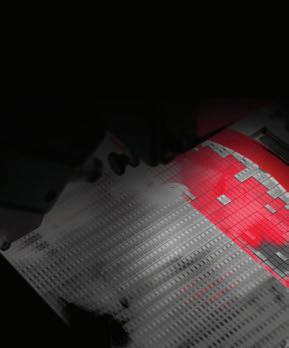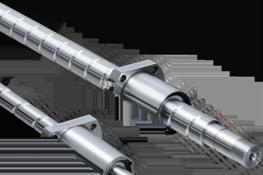
6 minute read
How to Evaluate IoT Platforms
A digital transformation can’t take place without a software architecture capable of supporting it. Given that, what factors should most influence your decision on an Internet of Things platform?
Nearly every major automation technology supplier oers Internet of Things (IoT) platform software as a means of providing an architecture around which to coordinate your plant floor systems for information technology (IT) consumption and collaboration. But how should you go about assessing these platforms, which can appear both very similar and distinctly dierent from each other.
One of the first things to understand is that the IoT is about open interoperability and scalable connectivity. In the consumer space, IoT developers have the luxury of designing with only IoT compatible devices in mind. Devices like modern smartphones and tablets or purpose-built IoT devices. In the industrial space, however, backwards compatibility is often a significant consideration because of the cost involved in replacing existing systems and because of the
long lifespans of most industrial installations.
As a result, one key aspect of IoT platform consideration involves understanding the extent to which your control system relies on different classes of equipment, such as hardwired equipment (no automation), standalone equipment (automated but not integrated), legacy automation equipment (automated but requires middleware to integrate), and greenfield equipment (which can be designed to spec). An IoT platform should be evaluated based on its ability to integrate each class of equipment you have identified.
Once you have a handle on this, the next step involves evaluating the need for incremental rollout. The more existing equipment and automation you already have in place, the more a new IoT platform must be capable of being rolled out over time so that process downtime can be scheduled appropriately. In many cases the requirement will be to eliminate downtime, so the platform must be able to deploy completely in parallel with existing systems.
A final aspect of the process is evaluating the expected long-term integration requirements and overall scalability of the platform. Integration of existing and planned systems is one consideration, but an IoT platform must be able to scale eciently to accommodate new network nodes that will be added over time as well. The platform should scale smoothly whether the number of data-producing field devices increases over time or the number and demand of data-consuming business applications increases. Keep in mind that scalability can be restricted by overreliance on proprietary technologies that inhibit interoperability and inflate costs, or a lack of security and reliability features.
WHAT SHOULD BE INCLUDED? An IoT platform should reduce the dependence on costly, hard-tomaintain middleware. Middleware—in the form of programmable logic controllers (PLCs), I/O gateways, OPC servers, custom data processing applications, intranet/internet gateways, etc.—is costly because it often requires long-term licensing agreements to support various communication protocols, applications, and operating systems. And because the complexity of a system increases with the amount of middleware, this also inflates maintenance overhead and system instability.
In addition to reducing the complexity of industrial integration, another important aspect a viable IoT platform should have is security. Traditional automation integration systems left this as an afterthought, resulting in complex firewall schemes and network segmentation that further complicate integration eorts.
IoT platforms that provide a scalable, reliable architecture make it possible to distribute data consistently and to a greater degree than previously possible.
GREENFIELD VS. BROWNFIELD For greenfield applications, it makes sense to design data communications with IoT in mind. Over time, the simplicity of integrating new devices and equipment will pay for itself. That said, be cautious of locking into a single IoT platform built upon proprietary technologies or data models. Consider open-source components where possible.
For brownfield applications, the typical motivation for considering an IoT platform is the need to create a unified “backbone” network for predictive analytics or business intelligence systems, bringing together data from disparate networks across the organization and sourcing larger quantities of data more eciently than with existing middleware solutions.
WHAT ARE THE MOST CRITICAL FEATURES? Current and near-future drivers of data generation include artificial intelligence, advanced visualization, digital twins, predictive maintenance, and business intelligence. As Industrial Internet of Things systems grow in service of these applications, IoT platforms need to be able to scale eciently to support hundreds of thousands or millions of data providers and consumers on the
same network. With that said, scalability is a secondary attribute influenced by engineering and technological eciency as well as security and fault-tolerance.
Engineering eciency relates to the cost and eort required to integrate each data point. Traditional integration solutions involve many steps, such as specifying appropriate I/O modules or gateways, installing I/O systems, configuring PLCs/PACs (programmable automation controllers) to scan and transform I/O signals, configuring supervisory control and data acquisition or OPC servers to read controller data, and programming external applications to retrieve, transform, and deliver data to other systems in the organization. IoT platforms improve scalability by reducing this up-front eort and the ongoing maintenance for these systems.
Technological eciency relates to the on-the-wire data footprint required by communication protocols as well as secondary factors that influence engineering eciency. MQTT with Sparkplug B is often recommended both for its technological eciency as well as its contribution to improving engineering eciency.
MQTT uses a minimal data format and reports data only as it changes, which reduces network trac by almost an order of magnitude compared to traditional poll-response communication models. Sparkplug B compliance increases the interoperability and meta attributes of MQTT data without compromising eciency and contributes to auto-discovery of device tags (i.e., topics in MQTT language). The publish-subscribe communication model of MQTT further contributes to engineering eciency by oering the MQTT broker as the single source of all data rather than requiring redundant point-to-point connections between data consumers and data producers.
Increasingly open technologies (like MQTT) are being suggested as a priority consideration over proprietary technologies because of the potential impact on scalability. Industrial automation has long been hampered by vendors’ desires to monopolize industrial data, resulting in vendor lock-in and inflating project costs, and long-term operating overhead. High cost per data point inhibits scalability, regardless of how ecient the technology is. Proprietary technologies can also inhibit interoperability, requiring new kinds of middleware in order to take advantage of a particular data format, etc.
Finally, as a matter of course, systems can’t scale unless they are reliable. If data are vulnerable to corruption by cyberattack, power failure, or systemic instability, users won’t trust their data to an IoT platform or invest their money in expanding it.
SOLUTIONS FOR PRECISION LINEAR MOTION



NSK Compact FA Series Ball Screws


Smooth, silent, high speed positioning with virtually zero maintenance. Those are the goals for today’s automated systems. And NSK ball screws are widely considered the most capable in the world. Case in point: the Compact FA Series. Remarkably low profiles combine with superior rigidity and virtually silent operation for a wide range of precision-critical applications, and years of maintenance-free performance.
Download the literature at NSKautomation.com/CompactFA






